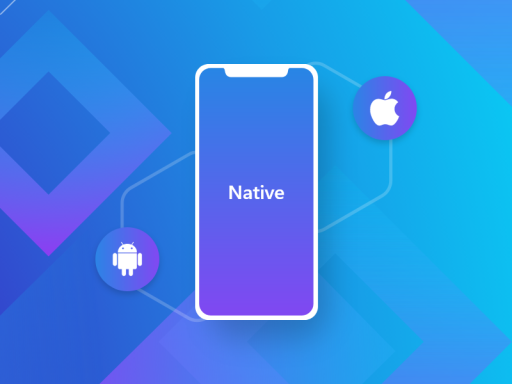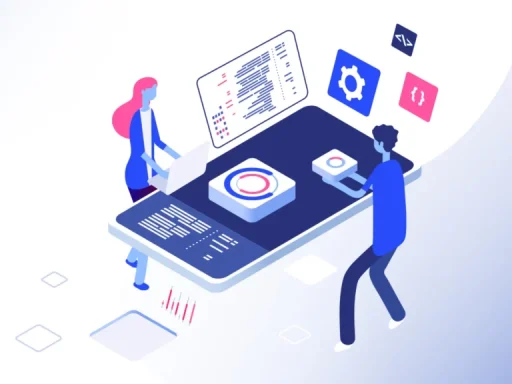Making a successful Fintech app in the USA takes a lot of requirements. The competition is fierce, user expectations are touching the sky, and regular compliance is constantly growing. With the right formula and plan and with the contribution of a strong team, a flourishing Fintech app can be created in this competitive market.
Customers now look for smooth, fast transactions, intuitive UI, and solid security protocols. If your app falters, they’ll abandon it for a competitor, which means no second chances. Basically, Fintech app development isn’t just about coding. It’s about earning users’ trust, upholding the highest standards of compliance, and giving them the results they expect.
Understanding the Fintech Ecosystem
The U.S. Fintech market is booming. Users are depending more and more on Fintech apps for everything from digital wallets to peer-to-peer payment systems, investment platforms, and mobile banking. Businesses can use their creativity and quickness to carve out a space for themselves in the financial sector by giving customers convenience and security.
These apps have reached a new level of mainstream acceptance. If you’re looking into Fintech app development, the secret is to stay updated on the trends. Mobile banking users expect strong app security, speedy transactions, and a user experience that doesn’t make them wait. A Fintech-savvy mobile app development partner can equip your startup with the necessary technical edge to succeed.
Step 1: Identify Your Niche and Audience
A better approach to Fintech app development is to define your specific user base and market niche. What kind of Fintech app are you building? Is it a personal finance tool, a lending platform, or a crypto app? Being clear about your niche helps in designing a solution that is all about your audience while still adhering to your niche. Rather than targeting generic platforms, you meet the requirements of the users.
Your audience matters just as much. If you’re targeting millennials, who are looking for better ways to save or small business owners who need streamlined invoicing. Are there any investors who want AI-powered insights? The clearer your audience, the better your app will serve them.
Step 2: Maintaining Financial Regulatory Compliance
Knowing your competition is equally as crucial as knowing your users. Take a close look at what the top Fintech apps are doing well and where they’re missing the mark. Analyze user reviews to see common complaints, study industry report insights, and keep an eye on market trends to identify what our app can fill. The goal isn’t just to build another Fintech app. It’s to create something that fills the gaps others have left open.
Step 3: Prioritize Security and Data Protection
Every industry faces difficulties when managing something as serious as security. In the same way, compliance is one of the most prominent concerns startups face in Fintech app development in the USA. The financial industry is highly regulated, and mostly Not meeting requirements for compliance can result in heavy fines or, worse, could result in the shutting down of your entire operations.
Some of the necessary regulations to keep in mind:
- Data Protection Standards (GDPR & CCPA)
- Customer Verification and Financial Crime Prevention
- Data Security for Payment Transactions
- Financial Trading Compliance
- Banking and Consumer Finance Regulatory Requirements
You can avoid future issues by working with Fintech app development providers like the ones at Appnality that specialize in compliance. It’s advisable to hire a legal consultant with finance expertise to ensure your app is fully compliant before launch.
Step 4: Deliver a User-Centric Experience
A Fintech app must be user-friendly, fast, and intuitive. Nobody wants to find a complex interface difficult to use when handling their finances. Here are some UX/UI best practices to follow:
- A minimalist design keeps it clean, simple, and easy to navigate.
- Keeping speed and performance steady with optimized quick transactions and a real-time update.
- Maintain personalization at all times high with AI-driven recommendations based on user behavior.
- Don’t forget dark mode, which provides immense accessibility and inclusivity for all users.
- Add gamification and encourage engagement with rewards, achievements, and financial insights.
Great Fintech app development involves both smooth functionality and a stellar user experience. An adept mobile app development company can help balance both.
Step 5: Choose the Right Technology Stack
Your Fintech app’s success in terms of performance, scalability, and security is heavily dependent on the selected tech stack. Here are some of the top choices:
- For frontend user interface development, choose React Native and Flutter for cross-platforms.
- For backend app development, go for Node.js, Python (Django, Flask), and Ruby on Rails.
- For data storage and management, PostgreSQL, MongoDB.
- For cloud-based solutions, AWS, Google Cloud, and Microsoft Azure.
- If you want advanced security protocols, choose Blockchain integration, AI-based fraud detection tools.
APIs, Plaid, Stripe, Yodlee, and Twilio for smooth financial operations.
Fintech app development startups should choose a tech stack that can grow in parallel with their long-term business needs. Partnering with a reliable mobile app development company in USA can help you make the right choices.
Step 6: Monetization Strategy
The revenue model of a financial app must be sound. A few successful monetization techniques are as follows:
- Offer subscription plans and charge users for premium features.
- Take transaction fees and earn from every transaction made on the platform.
- Offer lending, interest, and micro-loans and earn from its rates.
- Embrace a freemium model that offers basic features for free and charges for advanced functionalities.
- Provide your Fintech technology to other companies via licensing partnerships.
Maintaining the profitability of your financial app depends on selecting the appropriate monetization approach.
Step 7: Partner with the Right Fintech Development Services
To create a winning Fintech app, you must make use of technical expertise, industry insight, and strategic planning. Your mobile app’s potential for success is directly tied to the app development company you choose. Look for a partner with:
- Extensive history working with Fintech software.
- A strong portfolio of successful Fintech app launches.
- Specialized in secure Fintech app development.
- Development of infrastructure that supports growth.
- Dedicated app maintenance with updates and support.
By having a strong team, your Fintech app will be developed with long-term viability as a priority.
The Evolution of Finance Through Fintech
The way that consumers and businesses engage with financial services is being reformed by Fintech, or financial technology. While many associate fintech with startup culture and app development, its impact extends far beyond. Fintech is improving the efficiency, accessibility, and intelligence of financial institutions by reversing traditional banking practices and changing payments.
A Historical Overview of Fintech
Fintech has been developing over time. It isn’t a new concept. The financial sector has embraced technology for decades, and ATMs, electronic trading, and online banking are all early versions. However, the last decade has seen an explosion of innovation, and it’s all because of Artificial Intelligence (AI), Blockchain, Big Data, and mobile technology. The way consumers expect flawless, instant and error-free transactions, Fintech has been able to respond with smarter solutions that bypass traditional inefficiencies.
Benefits of Fintech
1. Financial Inclusion
Fintech’s ability to facilitate access to financial services for underbanked and unbanked communities is among its most important benefits. In many parts of the world, traditional banks are out of reach, but apps like Fintech enable mobile banking, microloans, and digital payments with just a smartphone, which is never out of your reach.
2. Lower Costs and Higher Efficiency
Traditional banking models, with their heavy infrastructure, contribute to increased operating costs. Fintech companies, on the other hand, use digital-first approaches, reducing costs significantly. This efficiency allows Fintech firms to provide greater interest rates and lower costs than standard banks.
3. Better Access to Credit
Fintech has brought about swift payment processing, enabling immediate, international financial exchanges. Transactions have become easier than ever since the introduction of peer-to-peer (P2P) payment platforms like Venmo, Zelle, and Cash App, which have removed the need for cash or checks.
4. Improved Security & Fraud Prevention
Advanced security protocols, including biometrics, AI-driven fraud detection, and Blockchain technology, make Fintech solutions more secure than traditional banking. These innovations decrease the chance of security threats and keep consumer data safe.
Challenges Faced in the Fintech Sector
Regulatory Complexity
Fintech operates under strict regulatory guidelines. Businesses face a complex compliance burden due to the diverse financial regulations across countries and states. Startups face the challenge of adhering to AML regulations, data protection standards, and consumer protection laws to avoid legal risks.
Cybersecurity Threats
With great technological advancements come greater risks. Fintech companies store massive amounts of sensitive user data, making them prime targets for cyberattacks. Customer trust can be damaged by data breaches, which can also lead to major financial losses.
Consumer Trust Issues
Despite many benefits of Fintech, consumers may hesitate to trust new platforms, especially when it comes to their money. Traditional banks have a long-standing reputation, while Fintech startups must build credibility from scratch.
High Competition
The Fintech sector is highly competitive, with both startups and tech giants such as Apple and Google entering the space. Striking a balance between unique market positioning and financial viability is a difficult task.
Integration with Legacy Systems
Many businesses still rely on outdated financial systems. Integrating Fintech solutions with these legacy systems can be costly and technically complex.
The Influence of Fintech on the Modern Living
Fintech is no longer a niche industry. It has become a core part of daily life. Digital wallets like Apple Pay, Google Play, and PayPal have made mobile payments faster and more secure, while robo-advisors like Wealthfront and Betterment use AI to help users invest intelligently without human advisors.
Cryptocurrency and blockchain technology, including Bitcoin, Ethereum, and decentralized finance (DeFi) platforms, are operating outside of traditional banking structures by offering decentralized financial services. Meanwhile, Buy Now, Pay Later (BNPL) services such as Klarna and Afterpay provide short-term financing options at checkout, refining consumer purchasing behavior. In the insurance sector, insurtech platforms use AI to automate claims processing and personalize policies, which makes financial services more efficient and accessible than they ever were before.
Final Thoughts
Fintech app development in the U.S. presents a mix of benefits and challenges. For a successful venture, you must hold onto a foundation of thorough planning, adherence to regulations, premium security, and a user-friendly platform.
Products made by startups cannot only satisfy consumer needs but also promotes long-term success by utilizing Fintech app development services from an established mobile app development company.
Frequently Asked Questions (FAQs)
-
What are the important parts of a good Fintech app?
A good Fintech app should have:
- Safe login options (like two-step verification or fingerprint logins)
- Quick processing of transactions
- Protection of user data and fraud alerts
- Easy-to-use design
- Following legal rules (like knowing your customer and anti-money laundering)
- Connecting with other services (like Plaid, Stripe, and Yodlee)
- Using AI for financial advice and automation.
-
What are the main challenges in making Fintech apps?
The main challenges are:
- Following laws: Dealing with strict financial rules in the U.S.
- Safety risks: Keeping user data safe from online threats.
- Building trust: Gaining respect in a crowded market.
- Growth: Keeping the app running well as more users join.
- Connecting with others: Joining banking services and payment systems easily.
-
How can I make sure my Fintech app follows the law?
To stay legal, your app should follow these rules:
- Know Your Customer (KYC) and Anti-Money Laundering (AML) rules.
- Payment Card Industry Data Security Standard (PCI DSS) for safe payments.
- California Consumer Privacy Act (CCPA) and General Data Protection.
- Regulation (GDPR) for data privacy.
- Securities and Exchange Commission (SEC) and Financial Industry Regulatory.
- Authority (FINRA) if you’re dealing with investments.
Getting a legal expert and working with a company that builds Fintech apps can help.
-
What technology should I use for a Fintech app?
A good technology setup for a Fintech app might include:
- Frontend: React Native, Flutter
- Backend: Node.js, Python (Django, Flask), Ruby on Rails
- Database: PostgreSQL, MongoDB
- Cloud storage: AWS, Google Cloud, Microsoft Azure
- Security: AI fraud detection, Blockchain
-
How long does it take to create a Fintech app?
The time it takes depends on how complex the app is:
- Basic version: 3-6 months
- Complete app: 9-18 months
- Getting legal approvals may take longer
-
How much does it cost to develop a Fintech app in the U.S?
Costs vary based on features, security, and legal needs:
- Basic Fintech app: $50,000 – $150,000
- Mid-level app: $150,000 – $300,000
Advanced Fintech app: over $300,000.





